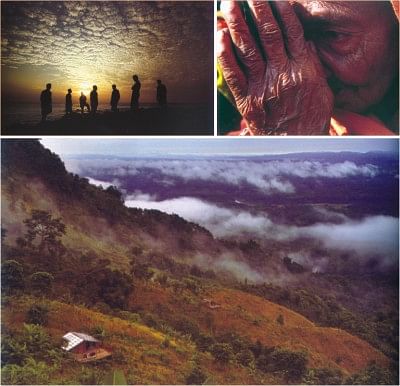When images speak

(Clockwise from top-left): A photograph by Mohammed Golam Sarower; “Devotion” and “Harmony” by M.M. Zahidur Rahman Biplob.
“Representing Bangladesh” is the title of an exhibition featuring two photographers MM Zahidur Rahman Biplob and Mohammed Golam Sarower. The exhibition is currently on at Drik Gallery in Dhanmondi, Dhaka.
Pathshala teacher Rafiqul Islam selected the best 40 images (each photographer contributed 20) for the exhibition. State Minister for Housing and Public Works Advocate Abdul Mannan Khan inaugurated the exhibition as the chief guest. Among others, accomplished photographers Golam Mustafa, Rafiqul Islam, Quazi Hamidul Haque and Chanchal Mahmud spoke at the inauguration.
“A photograph may tell many stories but, with the changing aspects of globalisation, many a photograph can tell a single focused story that we call documentary photography,” said Golam Mustafa.
“Bangladesh is an open studio for me. Earlier, I photographed to make a living, to tease my brain, and now I'm doing it to nourish my soul. I head to Bangladesh from New York, whenever I get the urge to explore my 'beloved studio',” said Quazi Hamidul Haque.
“Photography is still a neglected art form in Bangladesh. It has received no public and private patronage so far,” Chanchal Mahmud remarked.
Art is visually pleasing. If rays of beauty endlessly attract the aesthetic eye behind the lens, the art of photography is produced. The artiste duo roamed around from the Sundarbans to Bandarban, from Tanguar Haor to Nijhum Dwip, from Shomeswari river to St. Martin's Island, from Narail to Bagerhaat and other parts of Bangladesh in search of exquisite images. Impassable hills, unfathomable sea, pointed roots of mangrove forest did not appear as impediments to them. Four seasons -- monsoon, autumn, late autumn and winter -- of Bangladesh have been conspicuously highlighted through the images.
Nature and its elements, landscape and sunset are common images framed by both photographers. From a confused squirrel to a successful kingfisher, from a boasting butterfly to a twitchy dragonfly -- nothing has been left out from their artistic definition of nature.According to post structuralism, language is incapable of expressing universal meaning, as it is slippery; it rather conveys local, traditionally imposed meaning. Photography or any other visual art form has also a language of its own and claims to have universal meaning. When the language of images speaks, written words or lingual titles prove to be futile. Through attaching titles to their artworks, the participating photographers Biplob and Sarwar have seemingly done injustice to the larger-than-life images as they can speak for themselves.
In his image “Bangladesh”, the way Biplob has moved the wheel of childhood through the game of light and shadow on a tender morning is remarkable. As white rays dance with the azure and golden of the sky, it not only grips an art connoisseur but also anyone taking a peek.
Biplob's “Harmony” is a depiction of huts on the lap of a hill where flaky cotton candy-like clouds mingle with the mist. Images like this reminds one of the song “Darjeeling-er Gaan” by Kabir Sumon. “Abstract”, another photo by Biplob, shows sunrise on a beach -- delicately captured black corals look like a resting duck.
His other works feature a cautious deer from the Sundarbans, a lonely moon among clouds, an intriguing chameleon, blissful birds at leisure, a dedicated spider weaving its web, a devotional octogenarian woman, voyage of a bamboo fleet on a narrow creek and more. “Simplicity,” “Silence,” “Confident” and “Imbalance” are several portraits by Biplob.
Sarower's “Panoramic view of Bandarban” passionately speaks of the intermingling of lush green hilly forest with an autumn sky. Other images by him focus on the serene waves at St. Martin, dew drops trapped in spider webs, flowers from Narail, Nilgiri Resort in Bandarban, snails climbing a tree at the Sundarbans, coastal greenery and more.
Biplob has bagged several national awards in photography. Sarower has a professional degree from ICMAB. He won two international awards, including 1st prize at SAARC Charter Day 2006 organised by SAARC Agricultural Information Centre (SAIC).
The exhibition is open from 3 to 8 pm everyday and will continue till November 11.

 For all latest news, follow The Daily Star's Google News channel.
For all latest news, follow The Daily Star's Google News channel. 



Comments